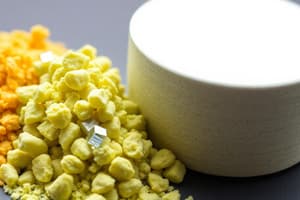Podcast
Questions and Answers
What does materials science involve?
What does materials science involve?
Determining the relationship between the structures and properties of materials.
What does a materials engineer try to create?
What does a materials engineer try to create?
A new material with desired properties based on an existing material.
What is the microscopic structure of a material defined as?
What is the microscopic structure of a material defined as?
- Structures visible under a scanning electron microscope
- Structures visible under an optical microscope
- Both B and C (correct)
- Structures visible to the unaided eye
Mechanical properties relate deformation to an applied load or force.
Mechanical properties relate deformation to an applied load or force.
The four components of materials are interrelated: structure, properties, processing, and ______.
The four components of materials are interrelated: structure, properties, processing, and ______.
Why is it important to know the limitations of material performance?
Why is it important to know the limitations of material performance?
What is a compound that ceramics are most frequently classified as?
What is a compound that ceramics are most frequently classified as?
What are metals typically denser than?
What are metals typically denser than?
What is one example of economic consideration when dealing with material choices?
What is one example of economic consideration when dealing with material choices?
Which of the following is not a basic classification of materials?
Which of the following is not a basic classification of materials?
Flashcards are hidden until you start studying
Study Notes
Material Science Introduction
- Material Science examines the relationship between material structures and their properties.
- Material scientists analyze how materials respond under various conditions, such as pressure and temperature.
Materials Engineering
- Focuses on creating or designing new materials with desired properties based on existing materials.
- Materials engineers modify characteristics of materials, as seen with tempered glass, which is made safer by increasing internal stress to prevent injury upon breaking.
Structural Analysis
- Microscopic structures are observable using tools like optical microscopes, scanning electron microscopes, and atomic force microscopes.
- Macroscopic structures can be seen without magnification and relate to overall material configurations such as crystalline or non-crystalline arrangements.
Material Properties
- Defined by characteristics that distinguish materials regardless of their size and shape, grouped into six categories:
- Mechanical: Relates deformation under applied loads.
- Electrical: Includes properties like conductivity and dielectric constant affected by electric fields.
- Thermal: Pertains to heat capacity and thermal conductivity of solids.
- Magnetic: Describes materials' reactions to magnetic fields.
- Optical: Relates to material behavior under electromagnetic radiation.
- Deteriorative: Concerned with chemical reactivity and the material’s resistance to environmental effects.
Four Components of Materials
- The structure, properties, and processing of a material are interrelated, influencing performance.
- Different processing methods can yield varied materials from the same atomic composition, for example, graphite and diamond from carbon.
Importance of Studying Materials
- Engineers and scientists must understand materials to select appropriate types for specific applications.
- Understanding trade-offs is essential; for instance, ductility often limits strength.
- Knowledge of material deterioration, such as corrosion from salt in beach environments, is vital for longevity and safety.
Economic Considerations
- Familiarity with costs is important; for example, while solar panels provide effective energy, their initial cost can lead to longer payback periods.
- Investing in high-quality materials (e.g., leather shoes) can be economical over time compared to cheaper alternatives.
Material Classification
- Basic categories:
- Metals: Includes Copper (Cu), Iron (Fe), Aluminum (Al), Zinc (Zn).
- Polymers: Organic compounds characterized by long chains of repeating units.
- Ceramics: Compounds formed from metallic and non-metallic elements, often in oxide, nitride, or carbide forms.
- Advanced categories:
- Composites: Materials made from two or more constituent materials with different physical or chemical properties.
- Semiconductors: Materials with electrical conductivity between conductors and insulators.
- Biomaterials: Engineered materials designed for interaction with biological systems.
Density and Properties of Metals
- Metals typically have higher density compared to ceramics and polymers.
- Variations in room temperature mechanical properties, such as stiffness and strength, are significant among metals, ceramics, and polymers.
Studying That Suits You
Use AI to generate personalized quizzes and flashcards to suit your learning preferences.




